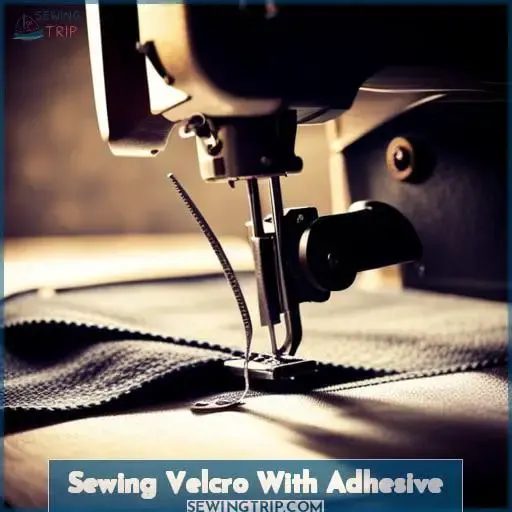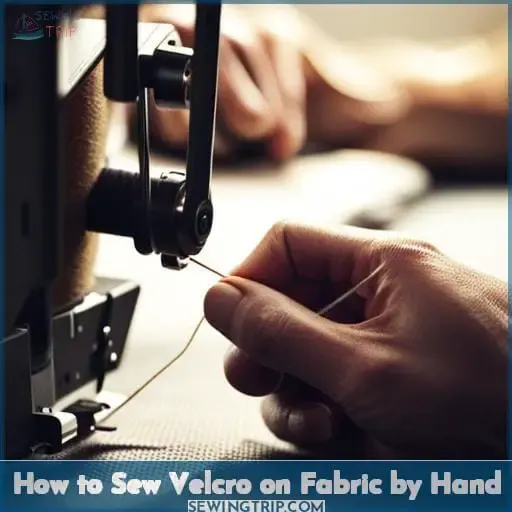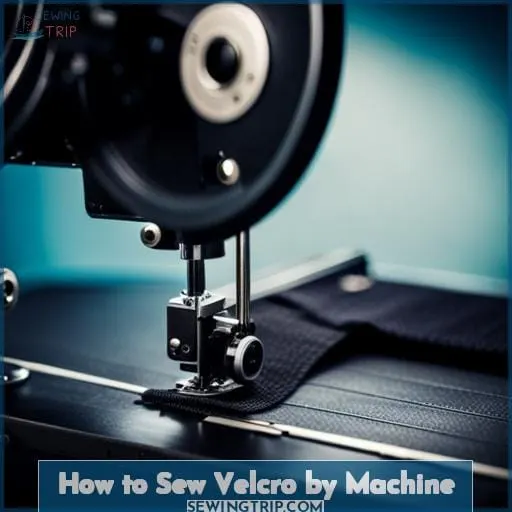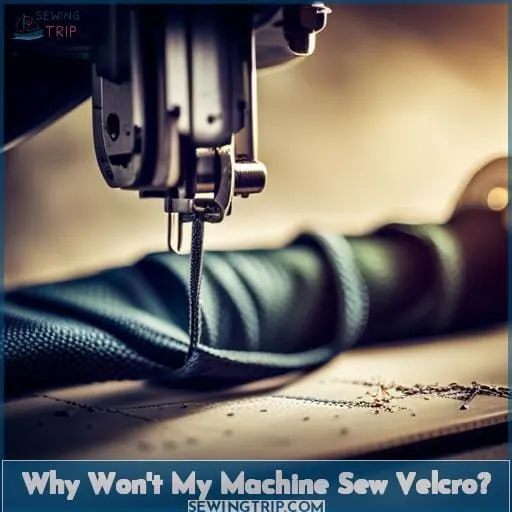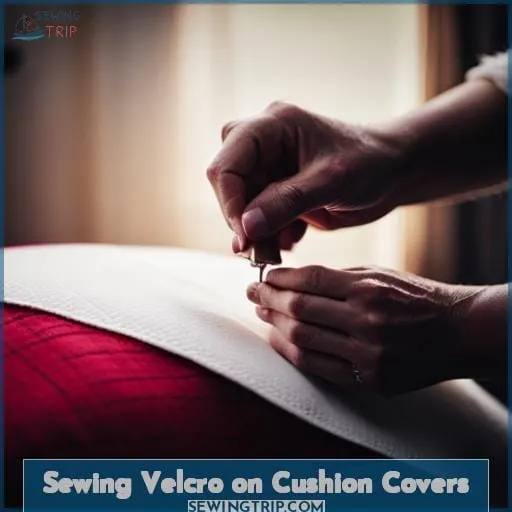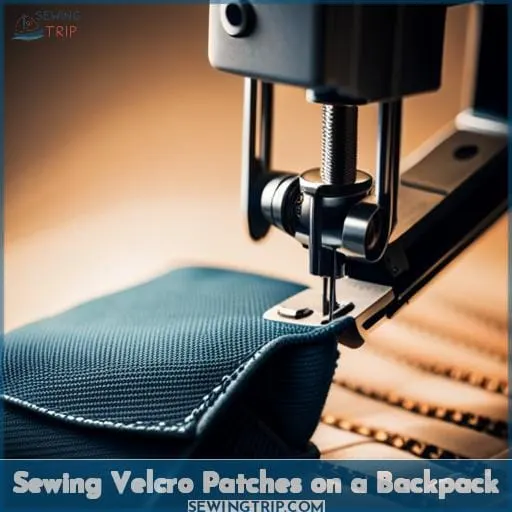This site is supported by our readers. We may earn a commission, at no cost to you, if you purchase through links.
 Imagine finally mastering the art of sewing sticky Velcro. No more frustration or time wasted on tedious projects. With this article, you’ll learn the techniques and tips to become a pro at sewing Velcro onto fabric.
Imagine finally mastering the art of sewing sticky Velcro. No more frustration or time wasted on tedious projects. With this article, you’ll learn the techniques and tips to become a pro at sewing Velcro onto fabric.
From choosing the right type of Velcro to using the proper tools, we’ve got you covered every step of the way.
Table Of Contents
- Key Takeaways
- Can You Sew Velcro on Fabric?
- Can You Sew Adhesive Velcro?
- How to Sew Through Sticky Velcro
- Sewing Velcro With Adhesive
- How to Sew Velcro on Fabric by Hand
- How to Sew Velcro by Machine
- Why Won’t My Machine Sew Velcro?
- Sewing Velcro on Cushion Covers
- Sewing Velcro Patches on a Backpack
- Frequently Asked Questions (FAQs)
- Conclusion
Key Takeaways
- Choose the appropriate size and type of sticky Velcro for your project.
- Use a new, sharp heavy-duty needle lubricated with beeswax or needle lubricant.
- Sew slowly and carefully to prevent gumming up or breaking your needle.
- Clean any adhesive buildup from your needle regularly using acetone or nail polish remover.
Can You Sew Velcro on Fabric?
When it comes to sewing Velcro on fabric, there are a few key points to keep in mind.
First, choose the right type of Velcro for your project and opt for a good quality option.
Additionally, use polyester thread and a sharp needle to ensure secure stitching.
Lastly, don’t forget to protect your fingers with a thimble while sewing through sticky Velcro.
By following these tips, you’ll be able to sew Velcro onto fabric with ease and precision.
Choosing the Right Velcro for the Job
You can sew Velcro on fabric by choosing the right type of Velcro for your project.
Consider factors such as:
- Fabric weight
- Hook and loop size
- Adhesive strength
- Color
- Durability
Sew-on Velcro is a popular choice as it provides a secure hold without relying on adhesive.
Ensure you select the appropriate size and type of Velcro based on your specific needs to achieve successful results in sewing velcro onto fabric or cushion covers.
Choosing a Good Quality Velcro
To ensure successful sewing with Velcro, it’s important to choose a good quality Velcro that meets your specific needs.
- Lightweight and durable: You want a Velcro that’s strong enough to hold securely but won’t weigh down your fabric.
- Sticky and reliable: Look for a Velcro with adhesive backing that will stay in place even after repeated use.
- Soft and comfortable: Consider the comfort of the wearer or user by choosing a soft, smooth surface on one side of the Velcro.
- Affordable and waterproof/weatherproof options available.
By considering these factors, you can find an affordable yet reliable option for all your sewing projects involving sticky velcros like sewing velcros patches on backpacks or attaching them through fabrics using machines.
Using a Polyester Thread
When sewing Velcro on fabric, it’s important to use a polyester thread for optimal results.
Polyester threads come in various types, weights, brands, and colors. They’re known for their strength and durability, making them perfect for securing the adhesive Velcro firmly in place.
Whether you’re sewing through sticky Velcro or looking for tips to sew Velcro applications with ease, using a high-quality polyester thread will ensure your stitches hold up over time.
Using a Sharp Needle
To sew Velcro on fabric, use a sharp needle for best results.
A clean needle will prevent any residue from gumming up your machine.
It’s important to keep your stitches small and tight to ensure the Velcro stays firmly in place.
If you’re finding it difficult to push the needle through, try using beeswax or a thimble for added grip.
Remember to sew slowly and carefully, paying attention to each stitch for precise and professional results.
Using a Thimble
If you want to sew Velcro on fabric, it’s essential to use a thimble for added protection and control while stitching.
The tiny metal shield fits snugly over your finger, preventing the needle from slipping and keeping your fingers safe from painful pricks or potential injury.
By using a thimble, you can confidently sew Velcro onto any fabric without worrying about hurting yourself in the process.
So don’t forget this important tool when working with sticky Velcro!
Can You Sew Adhesive Velcro?
You can’t sew adhesive Velcro.
The adhesive backing on sticky Velcro isn’t designed to withstand the pressure and movement of a sewing machine. Attempting to sew through it can damage your needle and potentially cause other problems with your machine.
Instead, consider using alternatives such as sewing regular hook-and-loop Velcro or using alternative fasteners like snaps or buttons for your projects that require a secure closure.
If you have already applied adhesive Velcro to your fabric and need to remove it, be cautious as removal can sometimes leave behind residue or damage the surface of the fabric. Use products like Goo Gone or acetone to help with any sticky residue left behind from removing sticky back velcro.
How to Sew Through Sticky Velcro
When sewing through sticky Velcro, it’s important to take precautions to ensure a smooth and successful stitching process.
- Use a sharp needle:
- A sharp needle will easily penetrate the adhesive backing of the Velcro without causing any damage or creating a messy stitch.
- Sew slowly and carefully:
- Sewing through sticky Velcro requires patience and precision.
- Take your time to guide the fabric smoothly under the presser foot of your machine, making sure not to rush or pull too hard on the fabric.
- Clean your needle regularly:
- Sticky residue from the Velcro can build up on your needle during sewing, leading to skipped stitches or thread breakage.
- Keep alcohol wipes nearby and periodically clean off any adhesive that collects on the needle.
By following these tips, you can sew velcro without ending up with a sticky mess all over your machine!
Sewing Velcro With Adhesive
To sew Velcro with adhesive, continue sewing through the sticky surface by following these steps:
- Cut off an 18 to 20 inches long strand of polyester thread that matches your fabric.
- Insert the thread through the eye of a heavy-duty sewing needle and tie a knot at the other end of the thread.
- Insert the needle through one corner of the Velcro so that it catches on to it.
- Push your needle down through the Velcro to create a straight stitch, also known as a running stitch.
- Bring it back up through another part of the Velcro to make another stitch.
By using this technique, you can securely attach adhesive-backed Velcro onto your fabric without any worry about its durability or longevity.
| Steps | Materials |
|---|---|
| 1 | Polyester Thread |
| 2 | Heavy-Duty Sewing Needle |
| 3 | Adhesive-Backed Velco |
How to Sew Velcro on Fabric by Hand
To sew Velcro on fabric by hand, start by:
- Cutting the Velcro to size and placing it between two pieces of fabric.
- Pinning the Velcro to your project using a single sewing needle skewered through the middle.
- Threading your needle with a 46- to 51-cm piece of thread and tie knots on both ends.
- Anchor the knot of the thread by pushing the needle from back to front of the Velcro.
- Using small, straight stitches, sew as close as possible to edgeoftheVelcrotostitchitsecurelytothefabric.
Handsewing velcron can be done on various fabrics such as:
- Leather for durable closures that can withstand heavy use
- Canvas for sturdy applications like bags or upholstery projects
- Denim, follow the same procedures for fabric and stitching techniques
- Felt is another suitable option where you can hand-sew velcron to add closures to crafts and small projects
- Suede, is also compatible with hand-sewn velcro closures, giving a professional finish where needed.
Ensure that you choose appropriate fabrics and thread to secure your Velcro pieces in place when sewing them together by hand.
How to Sew Velcro by Machine
Now that you’ve learned how to sew Velcro on fabric by hand, let’s explore the next step: sewing Velcro by machine. This method allows for quicker and more precise stitching, giving your projects a professional finish.
To successfully sew Velcro using a sewing machine, follow these steps:
- Cut the Velcro pieces to the appropriate size.
- Lay the soft side of the Velcro on top of one piece of fabric and place the scratchy side on another piece.
- Use a new, sharp heavy-duty needle lubricated with beeswax or needle lubricant for smooth stitching.
- If your machine has a special presser foot for hook and loop closures, use it; otherwise, opt for a zipper foot.
Remember these key tips as you sew:
- Keep stitches small to ensure secure attachment.
- Sew slowly to maintain control over your stitch length and prevent gumming up or breaking needles.
- Clean any adhesive build-up from your needle regularly using acetone or nail polish remover.
By following these guidelines while sewing sticky velco patches onto fabrics using machines helps in obtaining best results possible
Why Won’t My Machine Sew Velcro?
If you’re having trouble getting your machine to sew Velcro, slow down your stitching as much as possible.
Velcro is a tough and dense fabric that some machines may struggle with.
To solve this issue, try using a new needle specifically designed for heavy-duty materials like denim or leather.
These needles are stronger and more durable, making them better equipped to handle the demands of sewing through Velcro.
Additionally, make sure to clean the needle regularly to prevent any buildup that could affect its performance.
Another tip is to use beeswax on the needle before sewing; this lubricates it and helps it glide smoothly through the fabric without snagging or breaking threads.
By implementing these techniques, you’ll be able to overcome any difficulties in sewing Velcro with your machine.
Sewing Velcro on Cushion Covers
Are you looking to secure your cushions to a seat or make a cushion with a Velcro closure? Look no further! In this article, we’ll discuss how to sew Velcro on cushion covers, providing you with step-by-step instructions and tips for achieving excellent results.
How to Secure a Cushion to a Seat
Wondering how to securely attach a cushion to a seat? Here’s what you need to do:
- Use a zipper foot attachment on your sewing machine.
- Keep your stitches small and straight for maximum durability.
- Sew diagonally across the Velcro piece to ensure it’s secure in the center.
- Remember, sew slowly and carefully so that your needle doesn’t gum up or break during the process.
How to Make a Cushion With a Velcro Closure
Create a cushion with a Velcro closure by sewing the Velcro onto the fabric.
Start by cutting two pieces of cloth into your desired size and shape.
Sew around the edge, leaving a 3-inch-wide opening.
Turn it right side out and stuff it with feathers or foam.
Hand-sew a Velcro strip to one side of the cushion, then attach the other side to your chair for easy removal and cleaning.
Master how to sew a pillow with this simple technique!
Sewing Velcro Patches on a Backpack
Now let’s explore sewing Velcro patches on a backpack, ensuring a secure attachment for your custom patches.
When it comes to sewing Velcro onto your backpack, there are a few key considerations to keep in mind.
First, decide on the size of your Velcro patch based on its intended purpose and the available space on your backpack.
Next, carefully choose the placement of the patch to ensure optimal functionality and aesthetic appeal.
Consider using high-quality Velcro material that’s durable and long-lasting for maximum effectiveness.
Additionally, if you opt for adhesive-backed velcro patches instead of sew-on ones, be aware that they may require extra caution during stitching due to their sticky nature.
By following these guidelines and employing proper techniques when attaching Velcro patches onto your backpacks with needle and thread or utilizing adhesive options as necessary , you can achieve an expertly crafted result that will securely hold any custom patch in place while also adding personal flair to your bag.
Frequently Asked Questions (FAQs)
What type of needle should I use to sew through sticky Velcro?
To sew through sticky Velcro, use a heavy-duty needle that can handle the tough fabric.
Keep control of your sewing by using the right tools!
Can I sew adhesive Velcro onto fabric?
Yes, you can sew adhesive Velcro onto fabric.
Use a sturdy needle and clean off any adhesive residue with alcohol wipes.
Take control of your sewing projects by mastering the art of attaching Velcro!
How do I remove adhesive buildup from my sewing needle when sewing Velcro?
To remove adhesive buildup from your sewing needle when sewing Velcro, stop every few stitches and wipe away the residue with a cloth soaked in acetone or nail polish remover.
What type of thread should I use when sewing Velcro?
When sewing Velcro, use polyester thread for maximum strength and durability.
This type of thread will withstand the adhesive properties of the Velcro without breaking or unraveling.
Can I sew Velcro patches onto a backpack?
Yes, you can sew Velcro patches onto a backpack.
Mark the position of the patch, thread your needle, and sew along the edge of the Velcro loop.
Attach to your finished Velcro backing for a customized look!
Conclusion
To become a master at sewing through sticky Velcro, it’s important to:
- Choose the right type of Velcro.
- Use good quality materials.
- Follow the proper techniques.
Whether you’re sewing by hand or with a machine, these tips will help you achieve that perfect finish on your sewing projects.
So, take control of your sewing skills and start sewing sticky Velcro like a pro today!
Master the technique of sewing through sticky Velcro and elevate your sewing projects to a whole new level.



